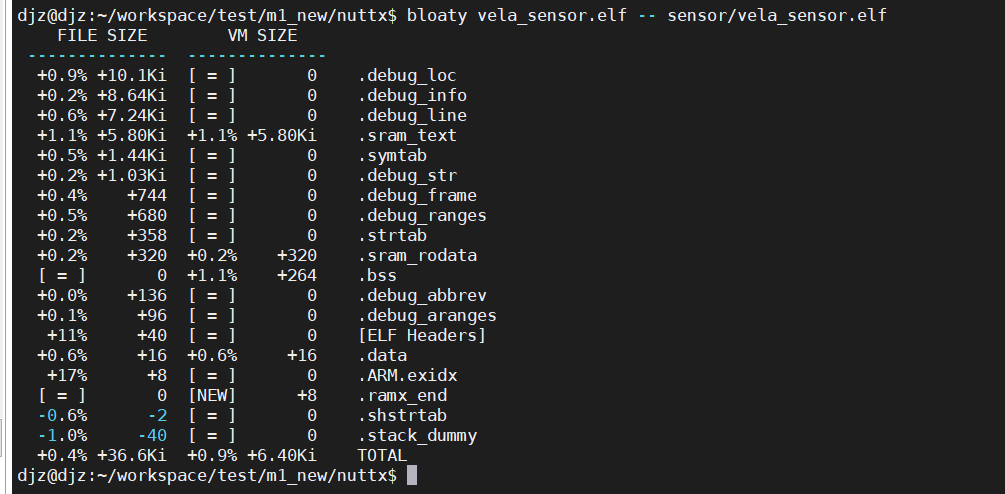openvela 时间系统
一、简介
本文档提供了时间系统的概述,包括关键时间概念、时间类型、API 和管理时间及时区的命令。
二、前置概念
1、世界标准时间(UTC)
- 定义:UTC 是全球统一的时间标准。
- 与北京时间(CST)的关系:北京时间比 UTC 快 8 小时,即 UTC+8。
2、日历时间(Calendar Time)
- 定义:日历时间是一种相对时间,用秒数表示从某个标准时间点到当前时刻的时间间隔。
- 特点
- 统一性:无论在哪个时区,同一时刻的日历时间相对于同一标准时间点始终一致。
- 标准时间点:通常以 UTC 时间 1970-01-01 00:00:00 为基准时间点(即 Unix 时间纪元)。
- 表示方式:以秒数形式表示,常用于计算机系统中作为时间戳。
三、localtime 在 openvela 中的实现说明
两种实现方式
-
打开 CONFIG_LIBC_LOCALTIME:
- localtime 的实现依赖 zoneinfo,可以根据时区正确转换时间。
- 优点:支持时区转换,功能更完善。
-
缺点:会增加代码体积, 增加约 6.4KB。

-
未打开 CONFIG_LIBC_LOCALTIME:
- localtime 和 gmtime 的效果相同,直接返回 UTC 时间,不进行时区转换。
- 优点:节省空间,无额外开销。
- 缺点:不支持时区转换。
四、设置时区
tzset 函数
-
从环境变量 TZ 获取时区信息,初始化以下内容:
- timezone :当前时区相对于 UTC 的偏移(以秒为单位)。
- daylight :是否启用夏令时(非零表示启用)。
1、TZ 环境变量格式
字符串格式
TZ 环境变量支持以下格式:
std offset[dst[offset][,start[/time],end[/time]]]
参数说明
-
std
表示时区缩写,由三个或三个以上的字符组成。例如:
- CST:中国标准时间。
- EST:东部标准时间。
-
offset
- 当前时区与 UTC 的偏移量。
- 格式为 ±hh:mm:ss,例如 +8:00:00 表示东八区(UTC+8)。
-
dst(可选)
表示夏令时时区缩写。
-
offset(可选)
- 夏令时相对于 UTC 的偏移量。
- 如果省略,默认比标准时间提前 1 小时。
-
start[/time],end[/time](可选)
表示夏令时开始和结束规则:
-
格式为 M<month>.<week>.<day>:
- M10.1.0:10 月的第一周的星期天。
- M3.3.0:3 月的第三周的星期天。
-
/time 表示具体时间(可选)。
-
文件路径格式
TZ 环境变量支持通过文件路径指定时区信息,格式如下:
-
路径格式。
- Asia/Shanghai:相对路径,表示系统时区目录(由 CONFIG_LIBC_TZDIR 指定)下的文件。
- /Asia/Shanghai:绝对路径,表示直接指定时区文件的完整路径。
- :Asia/Shanghai:同时支持绝对路径和系统时区目录下的相对路径。
-
解析规则:找到时区文件后,会根据 tzfile 格式解析文件内容,加载对应的时区信息。
2、zoneinfo 制作与挂载说明
zoneinfo 制作流程
-
tzfile 格式
zoneinfo 使用 tzfile 格式存储时区信息,具体格式请参考 tzfile文档。
-
数据库下载。
从 时区数据库 下载最新的时区数据。
-
生成 tzbin目录。
使用下载的时区数据,生成包含 zoneinfo 文件的 tzbin 目录,如下图所示:

-
生成 romfs 文件。
- 使用 Linux 工具 genromfs 将 tzbin 目录打包为 romfs 格式的镜像文件。
- 该镜像文件可挂载到设备上,供程序使用。
在模拟器和板子上的挂载方式
在模拟器(sim)中挂载
-
创建 RAM 磁盘。
mkrd -m 10 -s 512 102400- -m 10:指定 RAM 设备号为 /dev/ram10。
- -s 512:设置块大小为 512 字节。
- 102400:设置磁盘大小为 102400 个块。
-
挂载 hostfs 文件系统。
- 在当前路径下存放 romfs.img 文件,然后挂载:
mount -t hostfs fs=. /data
- 在当前路径下存放 romfs.img 文件,然后挂载:
-
将 romfs.img 写入 RAM 磁盘。
dd if=/data/romfs.img of=/dev/ram10 -
挂载 romfs 文件系统。
mount -t romfs /dev/ram10
在板子上挂载
-
找到文件分区起始地址。
- 使用下载工具,将 romfs 镜像文件烧录到对应的物理分区地址。
-
挂载分区。
- 挂载后即可使用时区文件。
zoneinfo 制作工具
-
自动生成。
-
在 libs/libc/zoneinfo/ 目录下的 Makefile 可自动下载时区数据库,并将其打包为 romfs 镜像文件,对应 config 如下:

-
运行 Makefile 后,生成 romfs_zoneinfo.img 文件。

-
-
挂载生成的镜像文件。
在模拟器中挂载:
mkrd -m 10 -s 512 800 dd if=data/romfs_zoneinfo.img of=/dev/ram10 mount -t romfs /dev/ram10 zoneinfo
指定时区文件位置
如果需要指定 zoneinfo 文件的位置,可以设置宏:
CONFIG_LIBC_TZDIR=/zoneinfo
3、设置时区的方法
通过启动脚本设置时区
在 rcS 启动脚本中设置环境变量(在调用 tzset 之后生效):
# 设置为上海时区
set TZ Asia/Shanghai
# 中国标准时间(无夏令时)
set TZ CST+08:00:00
# 设置为奥克兰时区
set TZ :Pacific/Auckland
# 设置为查塔姆时区
set TZ :Pacific/Chatham
# 新西兰标准时和夏令时
set TZ "NZST-12:00:00NZDT-13:00:00,M10.1.0,M3.3.0"
动态设置时区
通过代码动态设置时区:
-
调用 setenv :设置环境变量 TZ。
每个任务(task)都有独立的环境变量,因此可以持有不同的时区信息。
-
调用 tzset :同步时区信息。
命令行设置时区
使用命令行工具设置时区:
# 设置为东京时区
timedatectl set-timezone Asia/Tokyo
五、多核时区设置说明
在多核系统中,openvela 建议:
- UI 显示的核:负责设置时区信息,用于本地时间显示。
- 其他核:始终使用 UTC 时间,避免设置时区。
原因:
- 每个核的 tzset 是独立的,无法自动同步。
- 如果需要要多个核保持相同的时区信息,需要在每个核上单独调用 tzset设置时区。
建议:
- 除负责 UI 显示的核外,其他核尽量避免使用 localtime,统一使用 UTC 时间(即 gmtime)。
- 多核系统中打印日志统一采用 UTC 时间,保持一致性。
特殊情况:
- 如果多核需要访问 zoneinfo 文件:
- 当资源存储在 eMMC 中,其他核需要通过 rpmsgfs 才能访问 tzfile 信息。
六、时间类型
time_t
- 描述:存储从 1970 年 1 月 1 日 00:00:00 到现在经过的秒数。
- 实现:在 openvela 中,time_t 实现为 uint32_t 或 int64_t。
struct timeval
- 描述:提供秒和微秒单位,最高精度是微秒。
- 结构:
struct timeval { time_t tv_sec; // 自 1970-01-01 00:00:00 起的秒数 long tv_usec; // 微秒 };
struct timespec
- 描述:提供秒和纳秒单位,最高精度是纳秒。
- 结构:
struct timespec { time_t tv_sec; long tv_nsec; };
stuct tm
- 描述:提供详细的日期和时间信息。
- 结构:
struct tm { int tm_sec; /* Seconds (0-61, allows for leap seconds) */ int tm_min; /* Minutes (0-59) */ int tm_hour; /* Hours (0-23) */ int tm_mday; /* Day of the month (1-31) */ int tm_mon; /* Month (0-11) */ int tm_year; /* Years since 1900 */ int tm_wday; /* Day of the week (0-6) */ int tm_yday; /* Day of the year (0-365) */ int tm_isdst; /* Non-0 if daylight savings time is in effect */ long tm_gmtoff; /* Offset from UTC in seconds */ const char *tm_zone; /* Timezone abbreviation. */ };
七、时间 API
1、常用时间 API
time_t time(FAR time_t *timep)
- 描述:获取或设置当前日历时间。
- 参数:指向存储日历时间的指针。如果为 NULL,则函数返回当前日历时间。
- 返回值:返回当前日历时间,类型为 time_t。
- 示例:
time_t current_time; current_time = time(NULL); // 获取当前日历时间 printf("Current time: %ld\n", current_time);
int clock_gettime(clockid_t clockid, FAR struct timespec *tp)
- 描述:获取指定时钟的当前时间。
- 参数:
- clockid: 要获取时间的时钟。常见值:CLOCK_REALTIME、CLOCK_MONOTONIC。
- tp: 指向 struct timespec 的指针,用于存储获取的时间。
- 返回值:成功返回 0,失败返回 -1。
- 示例:
struct timespec ts; clock_gettime(CLOCK_REALTIME, &ts); printf("Seconds: %ld, Nanoseconds: %ld\n", ts.tv_sec, ts.tv_nsec);
int clock_settime(clockid_t clock_id, FAR const struct timespec *tp)
- 描述:设置指定时钟的时间。当 clockid 为 CLOCK_REALTIME 时,用于设置 UTC 时间。
int clock_getres(clockid_t clk_id, struct timespec *res)
- 描述:用于获取时钟精度,最高精度是纳秒。
2、时间转换 API
-
time_t timegm(FAR struct tm *tmp)
描述:将 struct tm 转换为从 1970-01-01 00:00:00 至今的秒数(UTC 时间)。
-
FAR struct tm *gmtime(FAR const time_t *timep)
-
描述:将从 1970-01-01 00:00:00 至今的秒数转换为 struct tm 格式的时间,并用 UTC 时间表示。
-
说明:gmtime_r 是线程安全版本。
-
-
time_t mktime(FAR struct tm *tp)
描述:将 struct tm 转换为依据本地时区的秒数。
-
FAR struct tm *localtime(FAR const time_t *timep)
- 描述:将从 1970-01-01 00:00:00 至今的秒数转换为 struct tm 格式的时间,并用本地时区表示。
- 说明:localtime_r 是线程安全版本。
-
FAR char *asctime(FAR const struct tm *tp)
- 描述:将日期和时间格式化为字符串并返回。
- 说明:asctime_r 是线程安全版本。
-
size_t strftime(FAR char *s, size_t max, FAR const char *format, FAR const struct tm *tm)
描述:将 struct tm 中的数据按照 format 的格式填充到字符串 s 中,长度最长为 max。
-
FAR char *strptime(FAR const char *s, FAR const char *format, FAR struct tm *tm)
描述:将字符串 s 按照 format 的格式解析,并初始化 struct tm 结构体。
-
FAR char *ctime(FAR const time_t *timep)
- 描述:返回一个表示当地时间(localtime)的字符串。
- 说明:ctime_r 是线程安全版本。
-
double difftime(time_t time2, time_t time1)
描述:返回两次时间的差值,单位为秒。
3、高精度时间 API
-
int gettimeofday(FAR struct timeval *tv, FAR struct timezone *tz)
-
描述:返回当前时间,包含自 1970-01-01 00:00:00 起的秒数和微秒数。
-
参数
- tv:指向 struct timeval 的指针,用于存储秒数和微秒数。
- tz:时区信息,通常传入 NULL。
-
示例:
struct timeval tv; gettimeofday(&tv, NULL); printf("Seconds: %ld, Microseconds: %ld\n", tv.tv_sec, tv.tv_usec);
-
-
int settimeofday(FAR const struct timeval *tv, FAR struct timezone *tz)
描述:设置系统时间(UTC)。
-
int clock_systime_timespec(FAR struct timespec *ts)
描述:获取系统的运行时间(内核版 API)。
八、命令说明
1、查看系统运行时间
ap> uptime
14:11:37 up 3 days, 16:49, load average: 0.07, 0.07, 0.072、设置时区
ap> timedatectl set-timezone Asia/Tokyo3、设置时间
ap> date -s "May 11 11:11:21 2022"4、查看本地时间
默认显示 localtime,无时区时显示 UTC。
ap> date
Wed, Oct 22 14:11:54 2104
5、查看 UTC 时间
ap> date -u
Wed, Oct 22 14:13:21 21046、查看时间和时区信息
ap> timedatectl
TimeZone: CST, 28800
Local time: Mon, Oct 17 16:23:46 2022 CST
Universal time: Mon, Oct 17 08:23:46 2022 UTC
RTC time: Mon, Oct 17 08:23:47 2022
openvela 操作系统专为 AIoT 领域量身定制,以轻量化、标准兼容、安全性和高度可扩展性为核心特点。openvela 以其卓越的技术优势,已成为众多物联网设备和 AI 硬件的技术首选,涵盖了智能手表、运动手环、智能音箱、耳机、智能家居设备以及机器人等多个领域。
更多推荐
 已为社区贡献68条内容
已为社区贡献68条内容







所有评论(0)